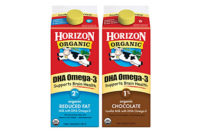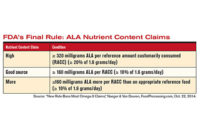If you’re not a fan of fatty fish or fish oil supplements, you’re likely not getting enough omega-3s for optimal heart and brain health. Omega-3s are essential fatty acids that are necessary for visual and neurological development in infants and confer several additional health benefits for adults such as normalizing blood pressure and triglycerides and reducing symptoms of rheumatoid arthritis, depression and age-related cognitive decline.
The two forms of omega-3s responsible for the majority of these health benefits are DHA and EPA, primarily found in fatty fish/fish oil. (Other forms, ALA and SDA, are converted by the body to EPA and DHA in insignificant amounts.) For heart health, the recommendation is 3 ounces of fatty fish at least twice a week or 1 gram (1,000 milligrams) DHA+EPA daily, according to the American Heart Association. On average, Americans get a mere 150 milligrams a day.
Enter omega-3 fortified foods. From a “food first” perspective, many experts believe that the best source of omega-3s — after fatty fish and before supplements — is omega-3 fortified food.
“The EPA and DHA in fortified foods are absorbed equally as well as from fish or fish oil supplements, as long as the fortified food already has some fat in it,” said Gretchen Vannice, registered dietitian nutritionist and industry consultant for omega-3s.
Ingredient options for omega-3 fortification of dairy products include:
- Fish oil, which provides DHA and EPA
- Algal oil, which provides DHA and is a vegetarian source (an EPA-only form of algal oil will soon be available)
- SDA-enriched soy oil. It may increase EPA, is a vegetarian source and is genetically modified
- Seed oils, which provide ALA
Major considerations for dairy processors are the delivered dose of DHA and/or EPA, the taste of the finished product and the cost, Vannice said. “Processors will get the most value from fish oil because it can be more highly concentrated than krill oil and krill oil is more expensive. The absorption of DHA and EPA are the same from either fish oil or krill oil — as long as they are added to foods that already contain some fat.”
Vannice believes that the more omega-3-rich food and beverage options consumers have, the better, especially for children who need adequate DHA and EPA for proper growth and development.
“Fish sticks don’t have much DHA and EPA,” she said. “Putting it in child-friendly cheeses and yogurts — maybe mac and cheese — would be a smart thing to do.”
Grass and supplements for cows
Another way to enhance the omega-3 content of dairy products is to alter the diet of dairy cattle. When cows are grass-fed or given feed supplemented with fish meal, flaxseed, or SDA-rich plant oils, the milk produced by the cows may be slightly to moderately higher in omega-3s. Unfortunately, the way the increases in omega-3s are reported can be misleading, noted Adam Lock, an assistant professor in the Department of Animal Science at Michigan State University. That’s because the omega-3 content of milk is mainly ALA and is very low to start with (less than 0.5% of total fatty acids). For example, if grass-fed cows produce milk that has 62% more omega-3s than milk from conventionally fed cows, this increase equates to an omega-3 content of 0.8% of total fatty acids (not a meaningful increase), and it’s mostly ALA.
Currently, Kentucky-based Alltech is researching the effects of algae-supplemented cow feed with the hope of achieving “meaningful” levels of DHA naturally in milk.
“We’re doing titration studies using different levels of algae in feed to see the levels of DHA that come through in milk,” said Becky Timmons, the company’s global technical director of algae project. “We’re seeing an increase in DHA and also changes in the overall fat composition that make it a healthier milk.”
In the company’s spray-dried algae, the algal oil is completely protected by the algae cell wall, which shields the oil from biohydrogenation in the cows’ rumen, Timmons explained. The algal oil is naturally incorporated into milk fat so that the DHA in the milk is very stable, even upon pasteurization, and there are no problems with “off” flavors.
Research is ongoing to develop DHA+EPA-fortified dairy products that are palatable. It may be possible for dairy products to be good sources of DHA+EPA, most probably via fortification. Regardless of their omega-3 content, dairy foods are all stars in terms of nutrition and taste.
“It’s important to recognize that all dairy products are an excellent source of nutrients and bioactive components,” said Lock, “and thereby have positive implications for human health.”




